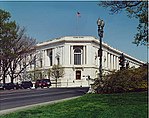New Jersey Avenue Station

The Washington Depot or New Jersey Avenue Station was a train station located in Northwest Washington, D.C., a block north of the Capitol. The train station was also called the B&O Depot as it was served by the Baltimore & Ohio Railroad. It operated from April 1851 until October 26, 1907, when Union Station commenced operation. During the American Civil War, the New Jersey Avenue Station was the major embarkation site for hundreds of thousands of Union troops. President Abraham Lincoln arrived there to be sworn in as President in 1861. It was from that station that his body along with his son "Willie" Lincoln began its long journey to his final resting place in Illinois after he was assassinated on April 14, 1865.
Excerpt from the Wikipedia article New Jersey Avenue Station (License: CC BY-SA 3.0, Authors, Images).New Jersey Avenue Station
New Jersey Avenue Northwest, Washington
Geographical coordinates (GPS) Address Nearby Places Show on map
Geographical coordinates (GPS)
| Latitude | Longitude |
|---|---|
| N 38.893527777778 ° | E -77.010194444444 ° |
Address
Capitol Hill Parking
New Jersey Avenue Northwest
20001 Washington
District of Columbia, United States
Open on Google Maps






